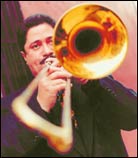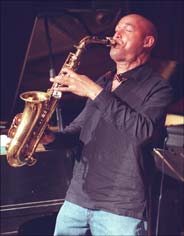|
 |
|
Esta página no está disponible en español. 'Papo' Vazquez: Charting Future Of Afro-Puerto Rican Music… Inspired By The Complexities Of Back-Country Troubadours
'Papo' Vazquez: Charting Future Of Afro-Puerto Rican Music By JEFF RIVERS, Courant Staff Writer June 4, 2004
Sometimes it's the trombonist's anger at being abused as a child that erupts from his horn. Sometimes it's the sorrow of his guitar-playing grandfather's death. Other times it's the joy of marrying the right woman that prances forth to a bomba beat, the traditional rhythm of his native Puerto Rico and the heartbeat of his soul. Perhaps people will dance when he and his band play. Vazquez likes it when people dance. That's why he keeps songs such as his "Like a Child" accessible. When the people dance, it's as if he's found a way to put the stories of a beautiful Caribbean island and its tough and tender people in the audience's bones. Sometimes, Vazquez says, his music makes people cry, so vivid are the memories engendered by the bomba and plena rhythms. After all, he says, it's not just his life that's in his music. The lives of others, their triumphs and pain, are there, too. A beautiful Caribbean island and islands of urban despair are in the New Yorker and former Philadelphian's music. So is hope and happiness, Vazquez says. That's why he loves to play for as many people as possible, so that more and more people can hear and feel a history that hasn't been captured in any book. "I try not to make it too complicated," Vazquez says. "If what we play doesn't get to everybody, we're not doing our jobs." Vazquez's history is rich and varied. Born in 1958, he began playing a $5 trombone as a child in Philadelphia, where black jazz musicians introduced him to still more rhythms and stories. They also helped spark his interest in musicians such as John Coltrane and trombone player J.J. Johnson. In the early 1970s, he moved to New York before beginning a career that has seen him play on movie soundtracks such as "Mo' Better Blues" and with the royalty of Latin jazz, including Celia Cruz, Tito Puente and Reuben Blades. He's also played with Ray Charles and Dizzy Gillespie. The elders, Vazquez says, taught him to practice until he got tired. They also taught the sci-fi buff and "Trekkie" to "go to the beach" and live life, otherwise "you'd have nothing to play." And trombone player Slide Hampton, Vazquez says, "really set me straight. He taught me how to blow into the instrument." Although Vazquez doesn't blow his own horn, his recordings (including "Carnival in San Juan") and live performances have caused some critics to hail him as the future of Latin jazz. If that's true, Vazquez says, it will be a future rooted in Afro-Puerto Rican music and not the more widely known and played Afro-Cuban music. "Cuba," Vazquez says, "has nothing to do with what we're playing." While he looks to his roots as a source of his music, Vazquez also seeks to stretch its boundaries. He's been commissioned to produce a symphony for a Bronx ensemble. Another mission is to spread the joy of his music and culture to young people. "What I know can't be taught in any school," says Vazquez, who describes himself as a "street musician." Still, he laments that public-school budget cuts resulted in too many of today's young people not getting a good music education. "So you got rap," Vazquez says, and young people who are "illiterates in the music." Vazquez wishes he had the resources to boost the musical understanding of young people, who he believes suffer in their ignorance. "What we have now is a lot of people with an identity crisis," he says. Vazquez hopes to change that through music. "We [musicians] have to give. "I'm a giver. I want to be a service to the community. As Wynton Marsalis said, we provide a service to people they don't know they need." Papo Vazquez's group features Sherman Irby on alto sax and flute, Hector Martignon on piano, John Benitez on bass, Roberto Cepeda on percussion and vocals, Juan Gutierrez on percussion and Henry Cole on drums and percussion. Inspired By The Complexities Of Back-Country Troubadours By BEN RATLIFF June 5, 2004
The alto saxophonist Miguel Zenon performing at the Jazz Gallery. The young alto saxophonist Miguel Zenon has shown a ferocious sense of organization in the past. His first album, "Looking Forward," from 2001, was more evolved than most first albums: he already had a saxophone sound, strong and light, and his composing exhibited a broad intellect busily chewing up new jazz harmony and folkloric music of his native Puerto Rico. Recently, he was awarded a grant from the New York State Council on the Arts, administered by the Jazz Gallery, to write new music and present it at that space. And where many bandleaders benefit from grants simply by doing more of what they're already doing and giving it a collective title, Mr. Zenon conceived a discrete, research-intensive project that has resulted in his best music yet. "Jibaro Journeys: Music From the Mountains of Puerto Rico," which had its first performance on Thursday night at the Jazz Gallery, needs some more bandstand exercise. A greater sense of intuition and casual play will eventually seep in. But I've rarely seen a jazz composer step forward with a project so impressively organized, intellectually powerful and well played from the start. Mr. Zenon examined his own musical roots, as so many new-world composers have, and found things he could use. He became entranced by the jibaro singers of Puerto Rico — the back-country troubadours of the island. Their musical folklore is jammed with form, and one of its glories is the décima, a song divided into 10-line stanzas with a rhyme-scheme of ABBAA and CCDDC; each line has eight syllables, and the mark of a great jibaro singer is the ability to improvise the whole thing. Mr. Zenon has taken up the idea of the décima as well as that of the other song genres, the seis and the aguinaldo. Instead of traditional Puerto Rican string instruments, he's using a jazz quartet of saxophone, piano, bass and drums. A composer's fascination with numbers isn't a graduate school contrivance. It's there in Steve Coleman's jazz (which is starting to shine more clearly as an influence on Mr. Zenon), in Puerto Rican mountain music, in Bach and in Pythagoras. Since the form of décima, in particular, is built around the numbers 5 and 10, Mr. Zenon took the concept further. He composed 10 pieces, 5 of them performed in each set on Thursday. He plugged the numbers into the music's harmonic material, using fifth chords. And in some pieces he followed the rhyme scheme of the décima, using mirroring musical phrases where a singer would use lyric rhymes. For whatever reason, all this theory set Mr. Zenon on fire: the outcome was a direct, powerful music, balancing folkish melody and infernally complex rhythm. The pieces were thoroughly written out, even (and especially) for drums. The driving vamps, based in Afro-Cuban rhythm, were unusually accented, and the pianist Luis Perdomo, the bassist Hans Glawischnig and the drummer Antonio Sanchez played them tenaciously. Mr. Zenon's own lithe, clean saxophone sound, floating in relaxed long tones over the crooked beat and then gnashing through tight chromatic patterns, has a human, casual quality; it counterbalances the impressive brain-stuff elsewhere in the music. The band played through this load of written music without faltering. But when it learns to relax and improvise within it, the achievement will be even greater.
|

 Storyteller and teacher, jester and historian, Angel "Papo" Vazquez says he plays his life on stage and in the recording studio.
Storyteller and teacher, jester and historian, Angel "Papo" Vazquez says he plays his life on stage and in the recording studio. PHOTO: Hiroyuki Ito for The New York Times
PHOTO: Hiroyuki Ito for The New York Times